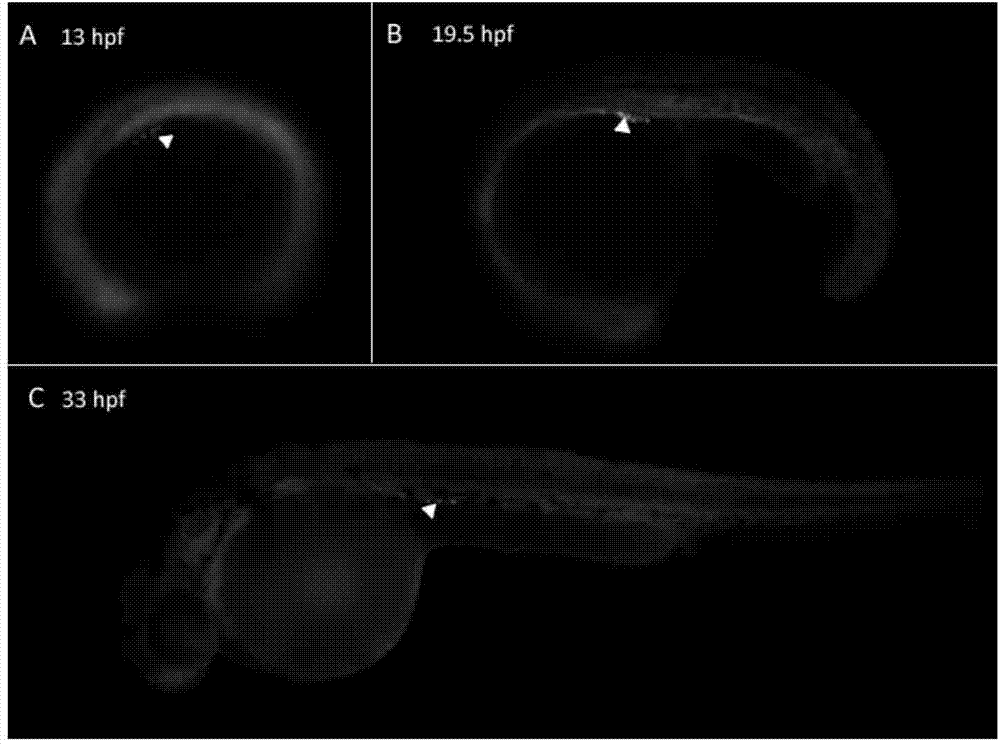Regulatory sequence of flounder primordial germ cell Nanos3 gene and applications thereof
A primordial germ cell and regulatory sequence technology, which is applied in the field of the regulatory sequence of the primordial germ cell Nanos3 gene of flounder, can solve the problem that the specific gene markers of PGCs are not obtained and so on.
- Summary
- Abstract
- Description
- Claims
- Application Information
AI Technical Summary
Problems solved by technology
Method used
Image
Examples
Embodiment 1
[0017] 1. RNA extraction and SMATer3'RACE library construction
[0018] The total RNA of flounder gonads was extracted with Trizol (Invitrogen), and the specific steps were as follows: Take about 0.1 mg of flounder gonads, add 0.1 mL Trizol, mix thoroughly, then add 0.9 mL Trizol, and place at room temperature for 5 min. Add 0.2 mL of chloroform, shake vigorously for 15 s, and place at room temperature for 3 min. 12000×g, 4°C, centrifuge for 15 minutes, and carefully take out the centrifuge tube after centrifugation. Take the supernatant into a new centrifuge tube, add an equal volume of isopropanol, mix well, place at room temperature for 10 min, centrifuge at 12000×g, 4°C for 10 min. Remove the isopropanol, add 1 mL of pre-cooled 75% ethanol to wash the precipitate, centrifuge at 7500×g, 4°C for 5 min. Remove the ethanol and place it in an ultra-clean bench to volatilize the ethanol. Add 30 μL of water (RNase-free), bathe at 55-60°C for 10 minutes to dissolve the RNA, tak...
Embodiment 2
[0047] The flounder Nanos3 gene can drive the specific expression of GFP:
[0048] In this example, the Nanos3 3'UTR was amplified by PCR (removing 710-737, which is the polyadenylic acid tail), and then inserted between the reporter gene GFP and PolyA in the GFP / pSP64-polyA vector by homologous recombination.
[0049] A fragment containing GFP, Nanos3 3'UTR (removing the polyadenylic acid tail) and poly A was obtained by PCR amplification, and RNA was synthesized in vitro after purification of the fragment.
[0050] The synthetic RNA was injected into zebrafish embryos at the 1-2 cell stage, and observed under a fluorescence microscope ( image 3 ), GFP expression was found in PGCs.
[0051] Specifically:
[0052] 1. Construction of GFP / pSP64-polyA
[0053] The primers used in PCR are as follows: GFP-pSP64-5:5’-AAGCTTGGGCTGCAG GTCGACATGAGTAAAGG AGAAGAA-3’; GFP-pSP64-3:5’-TGGGAGCTCGCCCGGGGATCCCTATTTGTATAGTTCATC-3’
[0054] Use endonucleases to linearize pSP64-polyA enzyme ...
PUM
 Login to View More
Login to View More Abstract
Description
Claims
Application Information
 Login to View More
Login to View More - R&D
- Intellectual Property
- Life Sciences
- Materials
- Tech Scout
- Unparalleled Data Quality
- Higher Quality Content
- 60% Fewer Hallucinations
Browse by: Latest US Patents, China's latest patents, Technical Efficacy Thesaurus, Application Domain, Technology Topic, Popular Technical Reports.
© 2025 PatSnap. All rights reserved.Legal|Privacy policy|Modern Slavery Act Transparency Statement|Sitemap|About US| Contact US: help@patsnap.com



